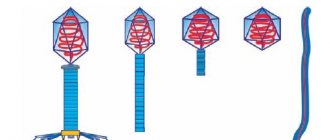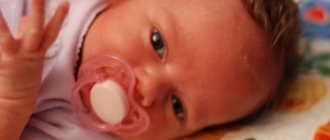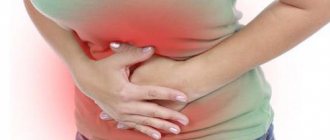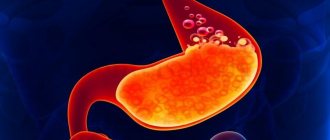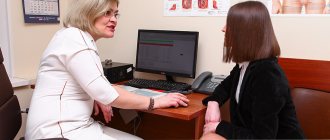Intestinal dysbiosis, symptoms and treatment regimen in adults
Intestinal dysbiosis is a disease accompanied by an imbalance in the ratio of beneficial and harmful bacteria.
The intestines of a healthy person are inhabited by an innumerable mass of microbes, 90% of which are representatives of obligate flora (healthy), 5-10% are facultative (conditionally pathogenic). Lactobacilli, bifidobacteria, anaerobic propionobacteria, Escherichia are involved in digestion, metabolism, protect against allergies, entry and uncontrolled reproduction of pathogenic organisms in the gastrointestinal tract.
Elements of conditionally pathogenic flora (fungi, fusobacteria, gram-negative bacilli, staphylococci, streptococci) do not cause diseases provided that a person has strong immunity. Under certain circumstances, the number of obligate flora decreases and the growth of pathogenic organisms in the intestines increases.
Normal microflora
This focus on the tiny inhabitants of the human intestine is explained by the fact that these microorganisms have an extremely positive effect on health. They have many beneficial functions. So, beneficial microflora:
- protect the intestinal mucosa from infectious agents, allergens, and excess opportunistic microbes;
- synthesizes vitamins (especially group B), antitumor substances, enzymes for the breakdown of proteins and sugars;
- neutralizes toxins and harmful metabolic products;
- reduces cholesterol;
- activates immunity:
- produces short-chain fatty acids, which ensure the integrity of the colonic mucosa;
- stimulates the absorption of necessary substances (water, iron, calcium, gases, vitamins E, D).
In addition to beneficial microbes (bifidobacteria, lactobacilli, etc.), opportunistic microorganisms (Klebsiella, Proteus, staphylococci, atypical Escherichia, Serracia, Enterobacter, yeast-like fungi, etc.) live in the intestine. In a healthy person, their number is strictly limited, so they do no harm. But when immunity drops, after intestinal infections, stress, etc. these insidious bacteria and fungi are activated, begin to multiply and have adverse effects, leading to clinical symptoms.
Causes
Dysbacteriosis does not necessarily develop in people with health problems. Quite often, the problem can appear in adults and children who have never previously experienced any problems with the digestive system.
The main reasons for the development of dysbiosis may be the following:
- Incorrect use of certain medications;
- Sudden change in food type;
- Eating poor quality food;
- Lack of fortified and fermented milk foods in the diet;
- Recent intestinal infections;
- Frequent use of antibiotics;
- Insufficient protection of the immune system;
- Having acute or chronic diseases - gastritis, pancreatitis, etc.
At the initial stages of development, dysbiosis may practically not make itself known. A person may only occasionally suffer from minor abdominal pain, bloating, and rare stool disorders.
How to treat flatulence at home?
The main way to treat increased gas formation at home is diet therapy. Avoid legumes, beer, kvass, baked goods, limit the consumption of apples and cabbage. All these products cause fermentation. It will be useful to include crumbly cereals, boiled vegetables, and fermented milk products in your diet.
In the absence of individual intolerance, home therapy can be supplemented with herbal decoctions. Teas based on mint, chamomile, dried ginger, and cumin seeds help relieve increased accumulation of gases. Young children can make dill tea.
The cause of bloating and increased accumulation of gases in the intestines may be a pathological process or infection. Treatment of flatulence includes taking medications prescribed by a gastroenterologist.
Symptoms of intestinal dysbiosis
In adults, the symptoms of dysbiosis are varied in their manifestation and severity. The severity of their manifestations depends on conditions such as age, lifestyle, immune system, and stage of development. In one person, a week of antibiotic therapy will cause only a slight disruption of the intestinal microflora, while in another it will cause severe symptoms of dysbiosis.
- Stage 1 of dysbiosis is characterized by a slight imbalance of normal and pathogenic bacteria. This condition may be due to a short course of taking antibacterial drugs or a change in usual food and water. At this stage, symptoms are mild and may be limited to minor intestinal upset. After completing antimicrobial treatment or getting used to new nutritional conditions, the balance of intestinal microflora is restored independently.
- At stage 2, the intestines cease to produce sufficient quantities of enzymes necessary for normal digestion of food. The result of this may be a fermentation process characterized by bloating, bitterness in the mouth, pain, flatulence, constipation or diarrhea. These symptoms may indicate the development of other diseases of the gastrointestinal tract, but most often indicate progressive dysbiosis.
- Stage 3 requires medical intervention, since pathogenic flora, affecting the intestinal walls in large quantities, causes inflammation. Symptoms become more pronounced, the patient experiences nausea and vomiting, undigested food fragments can be seen in the stool, patients complain of severe abdominal pain, and body temperature may rise.
- At stage 4, pathogens almost completely displace the beneficial intestinal microflora. In this case, the mechanism of absorption of nutrients is disrupted, which leads to the development of vitamin deficiency and anemia. In addition, toxins formed as a result of incomplete digestion of food and the activity of pathogenic microflora, entering the blood, cause severe allergic reactions. The previously described symptoms may include rash, eczema, hives, asthma, chronic fatigue, insomnia and problems concentrating. Lack of timely treatment threatens the development of severe intestinal infections.
It must be remembered that it is easiest to eliminate dysbiosis in its initial stages. If you discover a list of suspicious symptoms that do not go away within a couple of days, you should contact a gastroenterologist.
Dysbiosis with a predominance of opportunistic anaerobic microorganisms
Anaerobic dysbiosis is provoked by the predominance of anaerobic microorganisms in the microflora. Qualitative and quantitative changes in such pathology occur in the species diversity of microbial associations. Leukocytes under the influence of dysbiosis are almost completely destroyed. The male reproductive system becomes vulnerable to negative factors. The consequences of the anaerobic form of microflora disturbance are cystitis, urethritis, sexually transmitted infections and damage to the prostate gland.
Chronic dysbacteriosis
Chronic dysbacteriosis is somewhat less common. At the same time, disturbances in the composition and quantity of microflora do not return to normal for a very long time (months, years). As a rule, there are prerequisites that do not allow normal microflora to recover. However, in most cases, this problem can still be solved with proper treatment.
In the chronic course of dysbacteriosis, it is important to pay attention to the presence of the following factors:
- self-medication and unqualified treatment;
- weakened immune system;
- chronic inflammatory bowel diseases;
- non-compliance with the prescribed diet;
- presence of intestinal tumors;
- the presence of a constant source of infection (poor quality drinking water, etc.);
- possible resistance of bacteria to prescribed antibiotics (checked by antibiogram);
- chronic diseases of the liver, pancreas, stomach.
In the presence of the above factors, the prerequisites are created for changes in the composition of the intestinal microflora. If these factors are not eliminated, treatment in most cases will not have the desired effect. The disease takes a chronic course.
So, there is no such thing as “dysbacteriosis”?
Of course have. For example, pseudomembranous colitis - severe inflammation of the colon after an antibiotic - is a real dysbiosis: competitors have died, and therefore Clostridium difficile multiplies. Just to treat this, there is absolutely no need to state the obvious - the composition of bacteria in the intestine has changed. It is enough to confirm the infection (identify C. difficile toxins) and prescribe treatment.
Intestinal microflora, without a doubt, affects all processes in our body. By transplanting stool from an obese mouse to a mouse of normal weight, we induce obesity in the latter. The composition of gut bacteria is fundamentally different between people with anxiety and depression. Well, adding the probiotic Bacteroides fragilis to mice that have been artificially induced to have autism improves their social skills. Read the popular book “Look What's Inside You” by the famous microbiologist Rob Knight: our knowledge about microflora is colossal, but we are just beginning to apply it in practice (that is, to treat diseases).
The composition of bacteria can and should be studied. This is the subject of an ambitious international study, the Human Microbiome Project, with a budget of $115 million. Naturally, no “stool cultures” are used. Metagenomics methods are used to analyze the microbial jungle of the gut. They make it possible to describe how many unique DNA sequences are present in a particular person, which groups of bacteria predominate and which are absent. By the way, when such technologies (for example, 16S rRNA sequencing) appeared, it turned out that 75% of the species detected during genetic analysis of the same feces are not known to science at all.
Diagnostics
In order to determine the presence and nature of dysbiosis, it is necessary to find out which microbes populate the intestines and in what quantity. Today, two main diagnostic methods are practiced:
- The method for examining microflora metabolites is based on determining the substances (volatile fatty acids) that microbes secrete during their development. This method is highly sensitive and easy to determine microbes and allows you to get results within a few hours. In addition, it is not as expensive as bacteriological.
- Bacteriological research. With the bacteriological method, depending on the specialization of the laboratory, from 14 to 25 species of bacteria are determined (this is only 10% of all microorganisms). Alas, you will receive the result of this analysis only after 7 days; on average, this is the time it takes for bacteria to grow in special nutrient media and be identified. In addition, the quality of the results of this analysis also depends on compliance with delivery times and the quality of the material; there are also difficulties in cultivating certain types of bacteria.
It must be remembered that the composition of the intestinal microflora is individual for each person. It depends on age, food consumed, and even the time of year. Therefore, making a diagnosis based solely on tests is a mistake. Additional examination is needed to determine the cause of dysbiosis.
Complications
The most serious consequences can be caused by the following complications of dysbacteriosis:
- Losing weight. Progressive weight loss due to malabsorption is common in chronic dysbiosis. In some cases, patients become malnourished as a result of diarrhea. Regardless of the mechanism of exhaustion, the important thing is that the body weakens and becomes more susceptible to other diseases (acute respiratory diseases, chronic diseases worsen). Gaining body weight after prolonged dysbacteriosis is a slow process. More often, severe exhaustion is observed in children with severe forms of the disease.
- Dehydration. This complication is rare and occurs only in some severe types of dysbacteriosis. The fact is that long-term loss of water as a result of diarrhea can have very serious consequences for the body. Typically, dehydration is said to occur when there is a loss of 3% fluid or more. With a loss of 12% of fluid, the patient's condition becomes very serious and there is a high risk of life. Prolonged diarrhea with pronounced water loss is usually a consequence of the addition of dangerous pathogens that are not normally found in the intestines.
- Parasitic diseases. To a lesser extent, normal microflora protects the body from some parasitic diseases. We are talking about various helminthiases that are often found in children.
- Secondary intestinal infections. There are a large number of dangerous intestinal infections that do not affect the body, partly due to the presence of normal microflora. If this line of defense weakens, the likelihood of severe intestinal diseases increases. The most common infections that can aggravate dysbacteriosis and pose a threat to life are salmonellosis, shigellosis (dysentery), cholera, yersiniosis, etc. These diseases pose the greatest danger to children.
- Developmental disorders in children. In young children, dysbiosis without adequate treatment often becomes protracted. Because of this, the child may lack certain nutrients or vitamins for a long time. Given the high rate of growth and development in early childhood, such problems lead to delays in mental and physical development. Proper treatment can usually correct this deficiency in a child.
- Inflammatory processes. In rare cases (usually in the presence of concomitant inflammatory bowel diseases), serious changes in the microflora can lead to the development of an inflammatory process in the abdominal cavity. It is believed that chronic dysbiosis plays a role in the development of appendicitis, diverticulitis (inflammation of a diverticulum - a protrusion of the intestinal wall), and the formation of abscesses. Any inflammation in the abdominal cavity is potentially a very dangerous condition and requires intensive treatment (often surgical).
Considering the lack of vitamins and weakened immunity that occur with dysbiosis, there is a risk of other complications that are not directly related to disorders of the intestinal microflora. In general, we can say that dysbiosis is not a dangerous disease, but you still shouldn’t start the disease.
Results
- dysbiosis in men is provoked by a violation of the microflora;
- pathology can be manifested by deviations in the digestive system, the functional state of the genital organs, a tendency to allergic reactions and a deterioration in general condition;
- treatment of dysbiosis is carried out comprehensively (it is necessary to restore the microflora and stop the provoking factor);
- Lack of treatment for dysbiosis causes serious complications (infections of the reproductive system, progression of inflammatory processes, infertility and impotence).
Treatment of intestinal dysbiosis
In case of confirmed intestinal dysbacteriosis, planned treatment is carried out using drugs that restore normal intestinal flora and correct other disorders in the body (using enzymes, sorbents, vitamins).
Groups of drugs prescribed for intestinal dysbiosis in adults:
- Sorbents are prescribed for severe signs of intoxication. Activated carbon is prescribed 5-7 tablets at a time, for 5 days.
- Prebiotics - have a bifidogenic property, i.e. contribute to the stimulation and growth and reproduction of microbes that are part of the normal intestinal flora. Representatives of this group include: Hilak-forte, Duphalac. Hilak-forte is prescribed 40-60 drops 3 times a day.
- Antibacterial drugs are used for the 4th degree of intestinal dysbiosis, to destroy pathogenic flora. The most commonly used antibiotics are: tetracyclines (Doxycycline), cephalosporins (Cefuroxime, Ceftriaxone), penicillins (Ampiox), nitroimidazoles: Metronidazole, prescribed 500 mg 3 times a day, after meals.
- Symbiotics (Bifidobak, Maltodophilus) are combined preparations (prebiotic + probiotic), i.e. simultaneously stimulate the growth of normal flora and replace the missing number of microbes in the intestines. Bifidobac is prescribed 1 capsule 3 times a day, with meals.
- Bacteriophages. To eliminate the symptoms of dysbiosis, you can take medications containing viruses that attack a specific type of bacteria. They are combined with antibacterial treatment or used as an alternative therapy.
- Enzymes are prescribed in case of severe digestive disorders. Mezim tablets, 1 tablet 3 times a day, before meals.
- Antifungal drugs (Levorin) are prescribed if there are yeast-like fungi such as Candida in the stool. Levorin is prescribed 500 thousand units 2-4 times a day.
- Multivitamins: Duovit, 1 tablet 1 time per day.
The dosage, duration of treatment and group of drugs are prescribed by the attending physician, depending on the degree of dysbacteriosis. Below are the dosages of drugs for adults; for children, the dosage depends on the weight and age of the child.
How to collect stool for dysbacteriosis?
The coprogram allows you to diagnose diseases of the digestive system. Stool culture is carried out to identify the parasitic or infectious nature of the pathology. Before defecation, it is necessary to empty the bladder and carry out hygiene procedures. Cover the bottom of the toilet with paper or use a disposable plastic plate. Feces are collected in the morning or a maximum of 8 hours before delivery to the laboratory in a clean container.
3 days before collecting stool, stop taking antibiotics, laxatives, and iron supplements. 2 days in advance - exclude tomatoes, beets and other foods with a high content of coloring pigments, fatty and spicy foods from your diet. You cannot take the test during menstruation.
Probiotics
Probiotics (eubiotics) are preparations containing live microorganisms (i.e. bacteria of normal intestinal flora), they are used to treat grade 2-4 dysbacteriosis.
- 1st generation drugs: Bifidumbacterin, Lifepack probiotics. They are liquid concentrates of lactobacilli and bifidobacteria and are not stored for long (about 3 months). This group of drugs is unstable under the influence of gastric juice or enzymes of the gastrointestinal tract, which leads to their rapid destruction and the intake of insufficient concentrations, the main disadvantage of 1st generation probiotics. Bifidumbacterin is prescribed orally, 5 doses of the drug 2-3 times a day, 20 minutes before meals;
- 2nd generation drugs: Baktisubtil, Flonivin, Enterol. They contain spores of bacteria of normal intestinal flora, which in the patient’s intestines secrete enzymes for the digestion of proteins, fats and carbohydrates, stimulate the growth of bacteria of normal intestinal flora, and also suppress the growth of putrefactive flora. Subtil is prescribed 1 capsule 3 times a day, 1 hour before meals;
- 3rd generation drugs: Bifikol, Linex. They consist of several types of bacteria from the normal intestinal flora, and therefore are highly effective compared to the previous 2 generations of probiotics. Linex is prescribed 2 capsules 3 times a day;
- 4th generation drugs: Bifidumbacterin forte, Biosorb-Bifidum. This group of drugs consists of bacteria of normal intestinal flora in combination with an enterosorbent (with activated carbon or others). Enterosorbent is necessary to protect microorganisms when passing through the stomach, it actively protects them from inactivation by gastric juice or enzymes of the gastrointestinal tract. Bifidumbacterin forte is prescribed 5 doses 2-3 times a day, before meals.
Treatment of intestinal dysbiosis is prescribed comprehensively depending on the degree of the disease. Since dysbiosis develops under the influence of many factors, it is important to eliminate the cause of its development, otherwise taking probiotics will not have a positive effect. Elimination of foci of infection and chronic diseases is the main task in the treatment of dysbiosis.
University
→ Home → University → University in the media → “War” of intestinal microflora, or 10 questions about dysbiosis
The human body is home to up to 1016 microorganisms. This is more than 10 times the number of his own cells.
About 60% of microflora is found in the gastrointestinal tract. Any failure in the coordinated work of the microcosm can cause problems in many systems and functions.
1. What is dysbiosis? You can often find other designations - dysbiosis and enhanced microbial growth syndrome.
The term “dysbacteriosis” was proposed in 1916 by the German scientist Alfred Nissle, using this word to designate a quantitative change in E. coli. In 1972, the Soviet physiologist Alexander Ugolev described dysbiosis as a change in the qualitative and quantitative composition of the intestinal bacterial flora, which occurs under the influence of poor nutrition, physical and mental stress, serious illnesses, taking antibacterial drugs, surgical interventions, immunodeficiency, environmental pollution, etc. In our country, the term “dysbacteriosis” was introduced into medical use by academician Alexander Bilibin (1897–1976) to name qualitative and quantitative changes in the microbiocenosis of the intestine, especially the large intestine, disturbances in the species and quantitative composition of microbial populations in a certain biotope. Russian scientist Professor Yakov Zimmerman proposed the term “dysbiosis”: it reflects changes not only in the bacterial flora, but also in fungi, as well as metabolic, trophic and other disorders of the macroorganism associated with disturbances in the intestinal microecology. Today, the terms “dysbacteriosis” and “dysbiosis” are disputed and even denied by representatives of Western medicine and their supporters in our country. Instead of the concept of “dysbiosis”, “bacterial overgrowth syndrome” (SIBO) is popularized in the specialized literature (in English literature - bacterial overgrowth syndrome). However, it reflects a different pathophysiological and clinical situation - the spread of microbial growth into the small intestine (more than 105 microorganisms per 1 ml of intestinal contents in adults and more than 104 per 1 ml in children), i.e., not a qualitative, but a quantitative shift in the microcenosis. ICD-10 does not contain the terms “dysbacteriosis”, “dysbiosis” and “SIBO”. But in clinical practice they are actively used.
2. Can dysbiosis and SIBO be called independent diseases? Do they require treatment?
SIBO and dysbiosis are secondary syndromes that accompany many pathological processes. An imbalance of intestinal microflora is observed in irritable bowel syndrome, traveler's diarrhea, antibiotic-associated diarrhea, inflammatory bowel disease and other pathologies. However, this does not mean that SIBO and dysbiosis should not be diagnosed and treated. Disorders of intestinal microbiocenosis and an increase in the number of opportunistic and pathogenic intestinal microflora (Staphylococcus aureus, enteropathogenic Escherichia coli, Enterobacter, Proteus, Klebsiella, Pseudomonas aeruginosa, Shigella, Campylobacter, Clostridia, Candida, etc.) require therapy, because they cause and support local inflammation, are accompanied by intoxication and can lead to the development of sepsis. For subcompensated and decompensated intestinal dysbiosis, treatment is mandatory.
3. What are the causes of problems with intestinal microflora?
Dysbiosis develops as a result of infectious diseases and post-infectious conditions; after antibiotic, hormonal and polychemotherapy, the use of laxatives and sorbents; surgical removal of part of the intestine. Excessive, unbalanced and disordered nutrition play a role; deficiency of dietary fiber in the diet; consumption of products with an abundance of preservatives, dyes, xenobiotics; radiation damage to the intestines; Colon hydrotherapy. SIBO appears in hypo- and anacid conditions of the stomach; lactase and disaccharidase deficiency, celiac disease; chronic pancreatitis and cholecystitis, inflammatory diseases of the small intestine (Crohn's disease, Whipple's disease, vasculitis); neuropathies and myopathies; intestinal tumors and chronic constipation.
4. How to diagnose microbiocenosis disorders?
Since more than 500 species of bacteria live in the intestines (their total mass can reach 2.5 kg), it is not easy to determine violations of the quantitative and qualitative composition of microflora. The following methods are used: classical bacteriological analysis of feces (culture for dysbiosis) with determination of the main types of microorganisms; culture of intestinal contents obtained endoscopically on bacterial media (to determine SIBO); breath test with lactulose, xylose, labeled with the 14C carbon isotope; bacteriological examination of feces by PCR, FISH method, study of microbial metabolites (indican, phenol, paracresol, ammonia, etc.); gas chromatography-mass spectrometry of the generic composition of microorganisms, which allows you to detect living and dead microorganisms and find out their concentrations.+
5. How does dysbiosis manifest itself?
Symptoms are nonspecific; can be observed in diseases of the gastrointestinal tract that are not accompanied by a violation of microbiocenosis. The main symptoms are dyspeptic syndrome (belching, unpleasant taste in the mouth, increased gas formation, bloating, rumbling, diarrhea, pain and itching in the anus), maldigestion syndrome (impaired digestion and absorption of fats, meat, carbohydrates), abdominal pain, allergic reactions (bloating, loose foamy stools, itching, urticaria, Quincke's edema, bronchospasm, polyarthralgia). The presence of internal intoxication is very typical: weakness, fatigue, lack of appetite, headaches, fever. With a long course, malabsorption syndrome develops, manifested by multivitamin deficiency, weight loss, and anemia. During the day, several liters of gas are formed in the digestive tract, which is mainly absorbed by the intestinal wall. About 600 ml is excreted daily through the rectum, and with excessive bacterial growth, its amount increases to 2 liters or more.+
6. What treatment is needed for SIBO and dysbiosis?
Indications for the destruction of microbial contamination (decontamination) are SIBO and the presence of high titers of opportunistic microflora, which pose a threat of transfer of microbes to the small intestine. For this purpose, several groups of drugs are used: +
- antibacterial drugs;
- non-pathogenic fungi;
- preparations of spore-forming transient flora;
- microbial metabolites.
Antibiotics should not be absorbed from the intestines and suppress the growth of normal microflora. Rifaximin, a local intestinal antiseptic that is well tolerated and does not cause bacterial resistance, meets these requirements. The drug has a wide spectrum of action against opportunistic and pathogenic gram-positive (streptococci, staphylococci, enterococcus, tuberculosis bacillus), gram-negative (shigella, salmonella, yersinia, proteus, E. coli, peptostreptococcus, vibrio cholerae), aerobic bacteria, as well as anaerobic gram-positive ( clostridia, peptococcus) and gram-negative (bacteroides, Helicobacter pylorus). This drug is successfully used for the treatment of acute intestinal infections, correction of SIBO, sanitation of the colon in case of dysbacteriosis and hepatic encephalopathy. Rifaximin is used for a week at 400 mg 3 times a day. At the same time, the level of exhaled hydrogen decreases by 3–5 times already by the third day of therapy, which indicates rapid sanitation of the small intestine.
You can also use other antibacterial drugs: derivatives of hydroxyquinols (Intetrix), nitrofurans (nifuroxazide, or stopdiar), nitroimidazoles (metronidazole, tinidazole), enterofuril. Metronidazole and tinidazole are indicated for contamination with anaerobic microorganisms. Intetrix and nifuroxazide have an antimicrobial effect against Shigella, Salmonella, Yersinia, Campylobacter, Proteus, Klebsiella, pathogenic cocci, and Intetrix also inhibits the growth of fungi and amoebae. The duration of therapy for SIBO is 12–14 days.
An effective treatment for SIBO is enterol, which is a non-pathogenic yeast fungus of the genus Saccharomyces boulardii, obtained from tropical plants and fruits and possessing genetically determined resistance to almost all groups of antimicrobial drugs. The antimicrobial effect of enterol has been established in relation to a wide range of opportunistic microorganisms and protozoa. At the same time, enterol does not suppress the growth of obligate microorganisms in the intestinal cavity. These mushrooms have an antiviral and trophic effect (synthesize polyamines) and 2–5 days after the end of administration they are completely eliminated from the body without side effects. Enterol is used as an antidiarrheal and antiseptic for acute intestinal infections (as an alternative to antibiotics when their use is impossible), antibiotic-associated diarrhea, pseudomembranous colitis, parasitic diarrhea, dysbiosis, SIBO.
In case of grade IV colonic dysbiosis and the ineffectiveness of intestinal antiseptics, general resorptive antibiotics are needed, preferably fluoroquinolones (ofloxacin, ciprofloxacin, norfloxacin, pefloxacin); for pseudomembranous colitis - vancomycin, metronidazole, enterol, bacitracin.
Indications for antibiotics: microbial contamination of the small intestine; generalized form of dysbacteriosis; severe intoxication syndrome; persistent diarrhea syndrome; severe immunodeficiency.
The use of bacteriophages for intestinal dysbiosis has not lived up to the hopes placed on them: it provokes bacterial mutations.
To relieve symptoms of dysbiosis, regulators of intestinal motility (debridat, meteospasmil, motilium, dicetel, mucofalk, imodium), enterosorbents (smecta, enterosgel, enterodes) are used.
7. What biological drugs are used to treat dysbiosis?
There are several groups of biological agents for the correction of intestinal microflora disorders. Eubiotics, or probiotics, contain living obligate microorganisms; symbiotics - a combination of several types of living organisms; prebiotics - growth stimulators of normal microorganisms; synbiotics - live bacteria; prebiotic complexes - a rational combination of probiotics, prebiotics, sorbents, vitamins, microelements.
8. How do probiotics work?
In the broad sense of the word, these are living microorganisms and substances of microbial and other origin that have a beneficial effect on the physiological functions, biochemical and behavioral reactions of the body through the optimization of its microecological status. There are 4 generations of probiotics. The 1st includes single-component (colibacterin, bifidumbacterin, lactobacterin), i.e. containing 1 strain of bacteria. 2nd generation drugs (bactisubtil, biosporin, sporobacterin, etc.), based on the use of microorganisms non-specific for humans, are self-eliminating antagonists of pathogenic microflora. 3rd generation drugs include multicomponent probiotics, which contain several symbiotic strains of bacteria of the same type (acylact, acipol, etc.) or different types (linex, bifiform) with a mutually reinforcing effect. The 4th generation includes bifid-containing drugs immobilized on a sorbent (bifidumbacterin forte, probifor). Sorbed bifidobacteria effectively colonize the intestinal mucosa, providing a more pronounced protective effect than unsorbed analogues. The effects of these drugs on the human body: synthesis of nutrients and antioxidants (vitamins C, K, group B, folic acid, short-chain fatty acids, butyrate, nitric oxide); protective function (colonization of the colon mucosa, production of lysozyme, bacteriocins, decreased production of endotoxins, decreased mutagenicity); immunomodulatory (stimulation of macrophages, IgA synthesis, suppression of IgE synthesis, modulation of cytokine response); digestive (breakdown of carbohydrates, fiber, fats, proteins, deconjugation of bile acids); cytoprotective (neutralization of toxic substrates and metabolites, stimulation of regeneration and differentiation of the intestinal epithelium, anticarcinogenic effect of butyrate through the regulation of apoptosis).
9. What are prebiotics?
These are drugs or dietary supplements of non-microbial origin. They are not digested in the intestines, but have a positive effect on the body, stimulating the growth and/or metabolic activity of normal intestinal microflora. Typical representatives of prebiotics are compounds belonging to the class of low molecular weight carbohydrates: disaccharides, oligosaccharides, which are widespread in nature. Prebiotics should not be hydrolyzed by digestive enzymes and should be absorbed in the upper digestive tract. They selectively stimulate 1 species or a specific group of colon microorganisms. Oligosaccharides (soy oligosaccharide, fructooligosaccharides) are used as prebiotics; monosaccharides (xylose); disaccharides (lactulose); polysaccharides (pectins, dextrin, inulin), dietary fiber from herbs (psyllium), cereals (bran, Rekitsen-RD), fruits; peptides (soy, dairy); enzymes (saccharomyces proteases, etc.); amino acids (valine, arginine, glutamic acid); antioxidants (carotenoids, glutathione, vitamins A, C, E, selenium salts); unsaturated fatty acids; organic acids (acetic, propionic, citric); other substances (lecithin, para-aminobenzoic acid, lactoferrin, lectins, algae extracts, plant and microbial extracts). Prebiotics are best used in the initial stages of dysbiosis, as well as for its prevention.
10. Is herbal medicine prescribed for dysbiosis?
Treatment with medicinal herbs can become a preventive and auxiliary method of correction. The most famous plants that have an antibacterial effect against certain pathogenic microorganisms: apricot - suppresses putrefactive microorganisms, Proteus, Klebsiella, Pseudomonas aeruginosa; barberry (berberine) - hemolytic staphylococci, streptococci, dysentery bacteria, enterobacter; lingonberry (juice) - candida growth; strawberries - Staphylococcus aureus, Enterobacter; cranberries (berries) - putrefactive bacteria of the genus Proteus and Klebsiella; black currant - mushrooms and Staphylococcus aureus, influenza viruses; blueberries - staphylococcus, shigella; rosehip - gram-positive bacteria; apples - pathogenic E. coli, influenza A viruses. Their therapeutic effect is not strong and is observed only after prolonged exposure. Depending on the form and severity of dysbiosis, patients with disorders of the intestinal microflora can be recommended for home treatment for: staphylococcal dysbiosis - eucalyptus, St. John's wort, calamus, calendula, barberry, coltsfoot, Icelandic moss. The diet should include blueberries, rowan berries, strawberries, and raspberries; garlic, horseradish; mycotic candidal dysbacteriosis - linden, thyme, birch buds, eucalyptus, mint, lemon balm, fennel, sage, calamus, Icelandic moss, valerian, speedwell, elecampane, bergenia. You should eat lingonberries, carrots, wild garlic; yeast, potato, pumpkin and rice extracts; putrefactive dysbacteriosis - nettle, lingonberry, caraway, currants, cinquefoil, bergenia, birch buds, celandine, wormwood, maquea, burdock. Apricots, currants, rowan berries, lingonberries are shown; Jerusalem artichoke, red sweet pepper; Proteus dysbacteriosis - eucalyptus, calendula, calamus, plantain, St. John's wort, alder, bergenia, wormwood, cinquefoil erecta. Cranberries, raspberries, currants, peppers, garlic, and onions are useful.
There are 3 degrees of microbiocenosis disturbances.
Easy. The amount of bifid flora is reduced slightly, anaerobes predominate over aerobes, opportunistic flora is represented by no more than 2 species in titers up to 106. Average. The number of aerobes increases. The bifid flora titer decreases. The number of anaerobes and aerobes is approximately the same. Atypical forms of E. coli appear, and the titer of opportunistic microorganisms increases. Heavy. The number of aerobes exceeds the number of anaerobes. The titer of bifidobacteria and lactobacilli is sharply reduced. The number of opportunistic flora has increased - 107 and higher. Patients complain of stool upset, flatulence; there are signs of intoxication: fever, weakness, fatigue.
Anatoly Bliznyuk, Associate Professor of the Department of Polyclinic Therapy of BSMU, Candidate of Medical Sciences Medical Bulletin , June 25, 2014
Share
Diet for dysbiosis
How to treat intestinal dysbiosis? With a mild degree of imbalance in the intestinal microflora, it may be sufficient to eliminate these causes through a balanced diet, taking prebiotics or probiotics.
In case of severe disorders, dietary nutrition is also indicated simultaneously with complex antimicrobial therapy. Basic Rules:
- Products are steamed, boiled, baked, stewed. No frying!
- Drink plenty of fluids, mostly clean water. For diarrhea, it helps against dehydration, and for constipation, it softens clotted stool.
- The food is balanced, rich in foods containing proteins, carbohydrates, vegetable fats, minerals, vitamins necessary for the full functioning of the body.
- Remove foods that irritate the gastrointestinal tract, have a laxative or fixative effect.
- Avoid products that cause gas formation, fermentation, and rotting.
- Remove sauces, hot spices, smoked meats, marinades, and strong alcohol. No fast food, semi-finished products, dry food, on the go. Rich broths, confectionery, baked goods, whole milk, strong tea are prohibited.
- Eat foods that create favorable conditions for the growth of beneficial bacteria. They place emphasis on fermented milk products (kefir, yogurt, acidophilus milk), and foods rich in plant fiber.
- They refuse fresh vegetables and fruits. Any heat treatment is preferred. Baked apples are an excellent dessert, rich in vitamins and healthy elements.
- Eat food regularly, every 2.5-3 hours in small portions. Long intervals between meals should not be allowed.
- The temperature of the food should be pleasant and warm. You can't eat hot, it's too cold.
Diet is an important condition for the successful treatment of dysbiosis in adults and children. Food consumption is not limited, its composition is changed. A balanced diet and properly prepared food will help restore the lack of vitamins, increase hemoglobin, normalize digestion, and ensure complete excretion of bile.
How to treat intestinal flatulence?
First of all, it is necessary to determine what causes flatulence. Based on the diagnostic results, a treatment regimen is determined. If gas formation is caused by excessive swallowing of air, avoid chewing gum, soda, and snacks on the go. If the culprits of bloating are foods that enhance fermentation, their consumption will have to be limited or eliminated.
To prevent bloating, healthy people are advised to avoid too hot or cold foods, drinking large amounts of coffee, soda, sweets, yeast products, and snacks. Limit vegetables and fruits to radishes, green and onions, cabbage, and apples. The cause of heaving can be oats and products made from them, including muesli and quick cereal-based breakfasts. Some people experience rumbling and bloating after eating fried meat or high-fat foods.
Treatment for flatulence due to pancreatitis includes taking medications that replenish the lack of pancreatic enzymes. If the cause of increased gas accumulation is a tumor or adhesions, surgical treatment is prescribed. Flatulence due to dysbiosis goes away after the intestinal microflora is restored.
Can the patient do without treatment?
Cases of independent voluntary disposal of minor disturbances in the intestinal microflora are recorded quite often in medical practice. But most of these examples are associated with disorders due to emotional shocks or rapid acclimatization.
Please note that dysbiosis can stop progressing only in the first phase of its development. This is the big problem, because during this period it is almost impossible to notice characteristic changes in the intestinal microflora. And if the patient already has pronounced symptoms of the disease, then he needs medical help, since we are talking about a seriously advanced process.
Dysbiosis expressed in men
Severe dysbiosis is a pathological process accompanied by the most intense symptoms. The man has serious abnormalities in the digestive tract or characteristic signs of thrush. Disruption of microflora significantly reduces the patient’s quality of life. In most cases, dysbiosis of this type has a mixed form. To find out the reasons for its occurrence, a comprehensive examination and consultation with specialized specialists is necessary.
Prevention
The most important method of prevention is timely and rational antibacterial therapy. In this way, the patient can protect himself from the symptoms of dysbiosis and the development of the disease.
A common case of dysbacteriosis is long-term use of antibiotics. To prevent the disease, it is recommended to take the following measures:
- eat fermented milk products;
- start using antifungal drugs;
- take probiotics, multi-enzymes and multivitamins.
The complex of drugs must be prescribed by a doctor; it is not recommended to use any medications on your own.
Forecast
Timely and adequate therapy is a guarantee of getting rid of dysbiosis. Restoring microflora will speed up a man’s tendency to recover even in the presence of complications. If dysbiosis provokes additional pathological processes, and its symptoms are ignored by the patient, then the consequence may be irreversible deviations in the functioning of internal systems (chronic diseases of the genitourinary system, diseases of the digestive tract, immunodeficiency).
Video on the topic: Candidiasis (thrush) in men.
